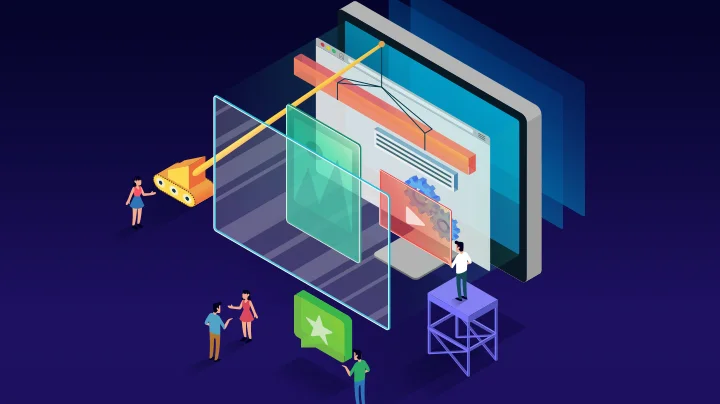UI and UX have long been confused and used interchangeably by most businesses and even by some developers.
For businesses, understanding this difference can help you identify if you need to hire a UI/UX designer and guide you to hiring a good candidate. For developers and aspiring UI/UX designers, knowing the difference can help identify the specific roles they have to take.
UX refers to ‘User Experience’ and UI refers to ‘User Interface.’ The two elements work hand-in-hand to create the design and features of a product. Despite working together as one, UI and UX have distinct roles in the design process.
Let’s learn more about each design element, the roles and responsibilities of UI and UX designers, and their differences.
What is UX?
Many are actually confused with the definition of UX, and that’s because of its origins.
UX is originally a cognitive science term. Cognitive scientist Don Norman coined the term User Experience and defined it as encompassing “all aspects of the end user's interaction with the company, its services, and its products.” This means, regardless of the medium, it’s applicable to any and to all interaction between potential or active clients and a company.
The term, however, was mostly used within the digital field for two arguable reasons:
- The digital industry started to grow during the term’s invention
- It was a ‘fancy’ term used to replace the already known practice of Market Research
Because of this, many people also confuse UX with Market Research, however, the two are only similar, but not the same. UX and Market Research are similar in a way that both use structure, analysis and optimisation of a customer’s experience to achieve an end goal.
This brings us to the core definition of UX design:
UX uses these techniques to enhance customer experience, satisfaction and loyalty by improving the overall interaction between a product and the customer. UX designers research, develop, test, and create prototypes to check for quality results.
As such, the key responsibilities of a UX designer include:
- Understanding product requirements and user psychology
- Conducting concept and usability testing and gathering response
- Creating personas through user research and data
- Identifying the right interaction model and evaluating its success
- Developing wireframes and prototypes depending on customer needs
- Solving UX problems such as in terms of usability and findability
- Coordinating with UI designers to implement visually appealing designs
- Communicating design ideas and prototypes to developers
- Keeping up-to-date with industry trends and competition
Based on these responsibilities, a UX designer is a complex and challenging role. They are more than just a designer, but also partly a marketer and a project manager. Among all of these responsibilities, ultimately, their role is to connect business goals to user’s needs.
What is UI?
UI or User Interface design is concerned with anything a user may use to interact with a digital product or service. It is a large field combining elements of:
- Content - texts, images, videos, and etc.
- Form - labels, buttons, checkboxes, text fields, graphic design, and etc.
- Behaviour - clicking, or dragging an item, typing on a text field
A UI designer’s role is to create attractive and engaging interfaces that will lead a user in their journey through the digital product or service and evoke a response from the user to make the product or service appealing to the users. A UI designer must effectively translate your brand into your product or service.
With this role in mind, here are the key responsibilities of a UI designer:
- Collaborating with product management and engineering to come up with solutions for product direction, visuals and experience
- Executing all visual design elements from concept to finish
- Conceptualizing innovative ideas from simple and user-friendly to complex designs
- Collaborating storyboards, wireframes, user flows, process flows and sitemaps
- Presenting and defending designs and key milestone deliverables to peers and executive level stakeholders, if needed
- Conducting user research and evaluating user reviews
Establishing and promoting design guidelines, standards, and best practices
Just like a UX designer, a UI designer has a multi-faceted role of creating ideas and visuals and communicating and implementing it with his or her team.
So… what’s the difference?
We already defined what UI and UX are, but you might still be confused about their difference. Their roles are similar, and sometimes overlapping, that it does become confusing. However, that just shows how UI and UX work closely together. To help you distinguish between the two, here are four key differences to remember:
- UX is not UI, but UI is UX
While both are concerned with designing interactions, UX is more concerned with the macro-interactions, while UI creates more of micro-interactions. UX designs the overall functions and features, while UI focuses more on the specifics and details. This is why UX can’t be UI because UI is under UX.
For example:
In the creation of a web page, a UX designer creates user flows such as the steps you have to take to sign up for an account. The design is then given to a UI designer who adds the necessary details, colours, and emphasis to give users an idea of how to successfully navigate the page. - UX creates useful interfaces, UI creates attractive interfaces
One of a UX designer’s responsibilities is to analyse the competition, develop personas, and develop and test a minimum valuable product that meets the needs of your market. Once done, the UI designer gets to work by making the interface visually pleasing by adding typography and details depending on the preferences of the persona created by the UX designer. - UX helps users accomplish goals, UI establishes emotional connections to users
Users have a goal in mind when they visit your site or use your project. It’s up to the UX designer to know what they value and what they are looking for to design an interface that can assist them with their needs.
For example:
If you’re creating a website for a mobile game, your UX designer must create a website layout that has all the components your user needs, such as developing wireframes and prototypes for subscribe button for updates, and a form to download the game. The UI designer will create a design that will attract, engage, and get users hooked to the site so it can entice users to download and try your mobile game. - UX first, then UI
UX design and research is the first step to developing a product as the research will verify the product idea and guide its development. Until you pat down your research and strategy, which is your UX, you can not move on to your UI. You will only start with UI when you are designing your product.
Basically, you need to plan your product before executing it.
That’s why the best approach is to do UX first, and then the UI.
Related Article: Front End and Back End Developers: A Quick Comparison
Hiring UI/UX Designers
For businesses, hiring good UI/UX designers can help your product become more engaging, useful and attractive to your users or customers. When hiring UI/UX designers, look for candidates that are knowledgeable and experienced in UX research, UX writing, wireframing and prototyping, coding, and analytics. Strong communication and collaboration skills are also a must-have for UI/UX designers as they will need to cooperate and coordinate with your team to produce a good output.
Should you hire freelance UI and UX designers?
Many businesses hire freelance UI and UX designers for a short time only thinking that the UI and UX designer’s job is done once they are finished with the product. However, in reality, UI/UX is a continuous process. Your products or services can still change over time, thus the UI and UX must also be updated.
Most freelancers prefer not to be tied down to just one company so they can explore projects. In the long run, hiring freelancers can be costly and risky as your freelancer may not be available in the future.
Aside from freelancers, hiring offshore UI/UX designers is also a good option to consider. With offshoring, finding good UI/UX designers is easier due to the larger tech talent available. It is also more cost-efficient due to the lower salary and cost of living in most offshoring destinations and less at risk due to the liabilities shared between the client and the offshoring provider.
Whatever hiring method you choose, it is important to note that you can’t hire a UX designer without a UI designer, or vice versa. The two work hand-in-hand to complete a product or website’s design thus both positions are necessary.
Need to create stand-out websites or applications? Hire globally recognised UI/UX designers with us today. Learn how Cloud Employee works, see our Developer Pricing Guide, or talk to us. You can hire dedicated offshore developers with us across many technologies.
Hire A Developer Now!
Featured Article

How to Become a High-Performing Developer

CSS grid vs. Flexbox: which to use when?

Download Our Developer Pricing Guide
We did an analysis on the difference between western and Philippines developer salaries. Uk, USA and Australia pricing comparisons available.
Download